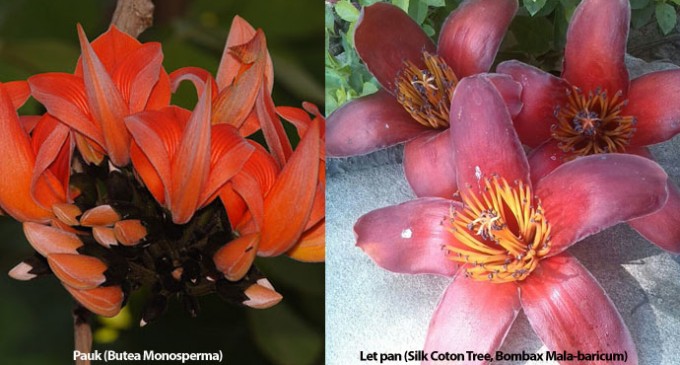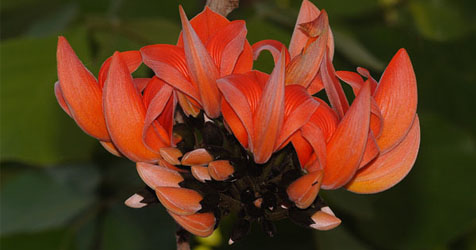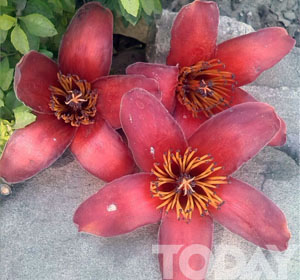FLORA IN MYANMAR CULTURE PAUK AND LEH (LET PAN)

Tabodwe, the eleventh month of Myanmar lunar calendar approximately corresponds to February. It is the last month of Myanmar cold season (Heiman of four months). Many Myan-mar old sayings describe the characteristics of this month ႏွာရည္ယိုရြဲ တပို႔တြဲ (In Tabodwe, we have running nose) ဆီး၀မး္ေပါက္ၿပဲ၊ တပို႔တြဲ In Tabodwe, plum fruits ripen. ထမနဲထိုးပြဲ၊ တပို႔တြဲ Traditional festival of making delicacy (gluti-nous rice cake) htamane is held in Tabodwe. In this month traditional festival of bon-fire offering to shrines, old monks and the aged to give them warmth to stand cold of the month is held and htamane delicacy is made and given gratis to all.
Two flowers are designated flowers of this month Pauk (Butea Monosperma) and Leh or Let pan (silk cotton tree, Bombax Mala-baricum). Both are flowers of Myanmar natural forest trees that grow wild in any part of the country. Pauk grows up to a height of 40 to 50 feet with its trunk 5 to 6 feet in circumference. Branches are artistically bent, leaves are thick broad and triangular, blooms are orange coloured coming out like festoons on all branches before new foliage appear looking like flames in the forest. Against the azure sky Pauk trees in full bloom are the favourite theme of Myanmar visual and performing artists. But Pauk flowers bear no fragrance. Therefore a rich handsome person with no education and no intelligence is likened to Pauk flower. When green leaves come out around orange coloured flowers parrots alight on them to catch and eat insects. You can hardly see parrots because their colours mingle with those of Pauk flowers and leaves. So in Myanmar literature, unpredictable political situation is likened to indistinguishable colour of Pauk blooms and leaves and colours of parrots (ရာဇေက်း ေပါက္နဲ႔ေက်း၊ ေက်းလည္း စိမ္းစိမ္း၊ ေပါက္လည္းစိမ္းစိမ္း) Pauk is a soft timber tree. Its wood is used for making light boat and farmer’s utensils. Sap of Pauk tree is used as lacquer and dye. It is also medicinal.
Let pan (Leh) is a tree rising to 120 feet high and its trunk maximum width is 12 to 14 feet. The trunk grows up straight and branches spread out at the top. Green leaves come out from all bran-ches. But in Tabodwe month before new leaves emerge, buds and blooms of scarlet colour burst forth in profusion. At the centre of the petals are stamens emitting pollen and nectar. Insects buzz around to eat pollens. Birds encircle to catch insects. Whereas bufferflies drink morning nectar. Especially minas birds alight in cluster and start twittering endlessly and noisily. So when you find people especially women talking noisily, you say ” like minas birds on let pan tree, talking noisily.”
Let pan is not a hard wood tree. Never-theless it is used for making household objects, boats, coffins, water containers, clogs and carving puppet figures. Its silky cotton from its fruits is used for stuffing pillow cases and cushions. Let pan blooms are dried in sun and preserved in pots for making sour soup.
Let pan grows along river and lake banks. They are grown on both sides of highway to provide shade and beautify landscape with its scarlet blooms and jade green foliage, noisy with twittering minas.
Let pan is medicinal. Herbalists use bark, root, flowers and leaves for making traditional medicine.
Sithu Dr Khin Maung Nyunt
./wp-content/uploads/2018/10/Emirate-Online-TDY.png)


















There are no comments at the moment, do you want to add one?
Write a comment